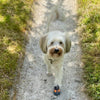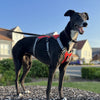How Do I Know If My Dog Harness Fits Correctly

Sometimes, a size guide and a few instructions are not enough. You receive your dog harness, proceed to fit it and then look a little puzzled when it just doesn't seem to fit correctly. So how do we know if a dog harness fits our dog? Here are a few things to check before you take it out on your first walk.
1. Take a look at the size guide from the supplier/manufacturer and see where your measurements fall within the range. If they are towards the smallest size, adjust the harness to its smallest setting. If it's towards the larger end, then adjust the straps etc to the largest setting. This will give you a good starting point and gives you the opportunity to make a final check of your dog's measurement against those shown by the supplier.
2. If you can't clip one of the straps in make an adjustment and loosen it until you can.
3. Get your dog to stand nicely or ask a friend to help you by supporting the dog in a natural upright, standing position.
4. Look at the main areas of where the harness fits and see if it is tight around the chest, neck, torso or back. If it is, loosen it off slightly. If it is too loose, adjust it so it fits snug but not too tight that it is pinching the skin.
5. Now walk with your dog, encouraging it and rewarding it as you go. If this is the first test walk in a harness, you want it to be a good experience. If the dog walks quite well and shows no major discomfort then the harness is probably not too tight or is not cutting into any of the sensitive areas.
6. Position your dog side on and look to see if there are any points where straps or pads are close to legs, or they are restricting the dog in any way. For example, some harnesses have a strap which fastens just behind the dog's front legs. Make sure this strap is not facing forward and is cutting into the pit of the dog's leg when it walks. You want this to be vertical or facing back away from the legs but there only needs to be a small gap between the leg and the strap when the dog is standing.
7. Now take a look at the straps all over the harness and make sure that none of them are too tight or too loose. A general rule of thumb here is to place one finger under the strap and you should feel a slight pinch. If there is hardly any pressure then the strap is probably a bit loose. If it feels like there is a lot of pressure on your finger then it may be too tight.
8. Attach a standard or double ended lead to your dog and walk around, reinforcing good walking behaviour with a reward. Now, go outside and walk normally and see if your dog seems comfortable. Let your dog sniff and do what it needs to do naturally.
9. Observe how the harness moves. There should not be a huge range of movement as it is designed to move with your dog and not be independent of it - the harness should not move from side to side or be overly slack in any area. Note: Sometimes there should be a compromise around the neck if a slightly loose fit means getting the harness on and off easily.
10. If your dog is very large or small in one area (the neck or chest) make sure that you can adjust the harness to fit well in these areas and this does not negatively affect other areas or adjustment points.
When you are out on a main walk for the first time, it is worth noting how your dog walks. If it is not interested in sniffing or exploring and/or looks in any discomfort, take one final look to see if there are any obvious reasons for this before trying to adjust it one last time. Please be aware that some dogs will show a reluctance to walk just to get attention.
If your dog has shown this behaviour before, distract it with something it likes as you walk and when it walks well or does something good, reward it. Please note that it is often better to play down anything new and not to make such a big fuss of it. Remember, dogs feed into our tone, gestures and personalities and they learn how to work us out and react to situations very quickly.
If your dog still shows a reluctance to walk with the harness, take it off, put it back on briefly and reward your dog. Take it back off again and put it to one side until later. Sometimes it is better to come back to it.
If you have measured your dog correctly and have followed the size guide and instructions given by the supplier, you shouldn't have any problems. In most cases, a harness only needs some minor tweaking and tuning to fit and to provide many years of walking support and pleasure for both dog and owner.
Sammi Long is the founder of Wiggles and Wags. To see our range of dog harnesses and accessories please click here.
-
Posted in
fitting a dog harness correctly, how do i know if my dog harness fits correctly, how to fit a dog harness





